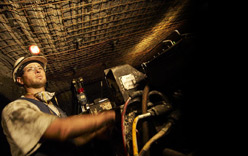Strata Reinforcement
Steel Reinforcement
Strata reinforcement is used in almost every mine
today to some extent, most commonly in the form of roof bolts. The earliest
roof bolts were steel rods with a split end with a steel wedge inserted. The
rod was installed into a hole drilled in the roof and hammered in so that the
wedge forced the steel to grip the sides of the hole. A nut at the outer end
was tightened against a washer and steel plate installed against the roof to
apply some tension and, with similar rods being inserted across and along a roadway,
the result was that strata beds in the immediate roof were clamped together to
form a stronger beam. The bolting pattern density was increased until the roof
then became self supporting. Such bolts were often installed through timber
bars to spread the support over more area and to aid in retaining broken
material. At times steel cross members were used instead of timber, the bolts
being installed through brackets or "saddles" to hold them in place.
Over time the split and wedge bolts were replaced by
improved methods of anchoring, eventually using fast-setting, two part resin
cartridges, the resin being mixed by the rotating bolt as it was inserted in
the hole. These bolts were initially anchored at the end of the bolt (referred
to as "point anchor bolts"),
and although tension was applied during the installation process, a lot of
movement occurred before the bolts became really effective.
It was found that better results were obtained if
sufficient resin was used to completely fill the hole drilled in the roof and
anchor the bolt over its entire length (referred to as "full column anchors") and these are now universally used for
primary roof bolting. The full column anchor also has the advantage of
protecting the bolt from corrosion in corrosive conditions.
Roof bolts were often used in conjunction with steel
straps in place of timber bars, the straps being stronger and better able to
mould into uneven roof, but still were mainly of use in retaining broken roof.
Most mines now use mesh sheets which completely cover the roof, held in place
by the bolts. They have minimal support function but prevent injuries from
falling material.
Other developments which have followed on from normal
roof bolts mostly relate to the length of reinforcement placed in the roof. The
maximum length of a normal bolt is the working height less the height needed
for the roof bolting machine. Initially if longer bolts were required they were
made in sections which could be screwed together. Later developments saw
flexible bolts (essentially lengths of wire rope), able to bend enough for
installation but stiff enough to push up the hole. Various designs of such
bolts are now available. They are mostly installed vertically or slightly
angled over the rib. They are too long for resin to be placed in cartridges and
the normal method of anchoring involves pumping a grout up a tube inserted with
the bolt. Sometimes a resin point anchor is installed initially, allowing the
bolt to be tensioned before being fully grouted.
A slightly different application for flexible bolts is
a "truss". These
consist of 2 flexible bolts installed at an angle over opposite ribs of a
roadway with long "tails" left in the roadway. The tails of each pair are
joined together at roof level and tension applied, so that there is a degree of
horizontal compression applied to the roof strata. The aim is to pre-stress the
roof to assist in preventing failure, although in many cases trusses have been
installed in already failed roof to act like a basket to retain the broken
material in place (still a valid strata control function).
The above comments refer to roof reinforcement, but
many mines use bolts in the ribs to prevent rib failure, usually in conjunction
with mesh. Rib bolts do not need the strength required for roof support, their
function being often to retain broken material in place more than to prevent
rib failure. Some rib bolts have to be installed in ribs which later have to be
mined, with a consequent need to remove the bolts before the coal is put into
the coal haulage system, which can be difficult. Various "cuttable" bolts have
been developed to allow mining to continue regardless of the presence of such
bolts.
On some occasions where floor heave is a problem,
bolts are also installed in the floor to help to control movement. Such bolts
need to be cut-off or installed completely below floor level to avoid tyre
damage if vehicles are required to use the roadway. They can also be a trip
hazard if proper precautions are not taken.

